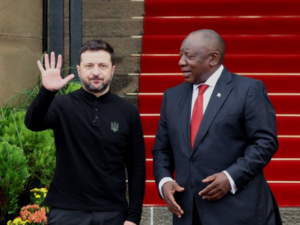Woolworths, despite being the mothership of the middle classes, just can’t seem to get it right.
Mostly because they’re permanently confused about who actually shops there.
They had those ridiculously skinny mannequins for a while, more representative of flamingos than actual people. Then there was that time that they had to recall children’s t-shirts after realising that the cute furry pom-poms on them, were made from real life cute furry animals.
They were also outed for using genetically modified ingredients.
Now they’re blaming their lack of financial growth on their “own fashion faux pas”, reports Moneyweb.
It is an excuse shareholders have heard before: the retailer’s growth was stunted by problems at Australian department chain David Jones, which Woolworths bought in April 2014 for R23.3 billion, and the poor execution of fashion choices in SA.
The group’s overall turnover grew 1.6% to R75 billion for its financial year 2018, with its SA clothing and general merchandise business leading the decline in sales. Sales fell by 1.5% due to what Woolworths describes as “poor execution” in womenswear.
Woolies CEO Ian Moir is pretty open about how and why they got it wrong:
“We went too young and fashionable with our womenswear. The garments, prints, and fit were wrong. We are a broad church, as our average customer age is 40-plus.”
Woolworths was attempting to compete with international retailers like H&M and Cotton On, which are perceived to offer value that attracts a young and fashionable shopper.
Ron Kiplin, a senior analyst at Cratos Capital, thinks that the problems at Woolies go deeper than just their bad fashion choices:
“Woolworths moved away from its basic style and dependable clothing to introduce David Jones and Country Road brands, which, in some cases, are not up to standard in terms of quality. The style is too different and the price is high. Customers don’t understand the Woolworths offering anymore.”

Woolworths shareholders have heard the excuse of botched fashion ranges before. The retailer was forced to engage in excessive promotional activity in 2016 due to a late start in winter. It also had to pull back its home-grown private label brands including Studio W and RE at David Jones stores in Australia.
Woolies plans on going back to basics in order to revitalise the business. This means simple clothes at affordable prices.
The strategy is not promising growth yet; sales in the first seven weeks of the new financial year fell by 1.7%.
So precarious is the clothing business that Woolworths has cut the operating profit margin guidance from 18% for the financial year 2019 to between 14% and 16%. “We want to make sure that the market is clear [about our challenges] and that we don’t over promise,” says Moir.
An improvement in the business is not going to happen overnight, he says, and double-digit growth “won’t happen anytime soon.”
The SA clothing business is key to Woolworths as it has traditionally generated nearly a third of the group’s operating profit. But for the period under review, Woolworths’s food business trumped clothing – R2.2 billion vs R1.7 billion against group operating profit of R5.3 billion.
Woolworths Food is currently saving the day with a sales growth of 8,4% and positive volume growth of 5,2% . People are starting to wonder how the retailer gets it so right with food and so wrong with clothing. I’m guessing avocado sales, especially in Cape Town.
According to Moir:
“Fashion is more difficult than food. It’s more fickle, seasonal and we have to make a lot more choices. It’s harder to do.”
But Damon Buss, an equity analyst at Electus Fund Managers, isn’t convinced. “Woolworths seems to lack the skills – both strategic and buying – to execute on the plans to ‘fix the fashion offer’,” he says.

The market’s patience for Woolworths to execute strategies that can deliver growth is wearing thin. This is after a R6.9 billion impairment of David Jones – proving that Moir overpaid for the acquisition – knocked the retailer into a loss of R3.5 billion and a 17.7% decline in headline earnings per share to 346.3 cents.
Woolworths shares are down 19.3% to R50.60 so far this year. This is more than its immediate food and clothing competitors, including Shoprite (down 3.5%), Pick n Pay (up 4.08%), Massmart (down 18.69%), The Foschini Group (down 6.85%), and Truworths (down 5.66%). Anthony Rocchi, portfolio manager at Rexsolom Invest, says its stock is trading close to fair value but remains 20% overvalued.
A look at their share price for the year to date is a pretty good indicator of their troubles:

Get it together, Woolworths.
[source:moneyweb]





